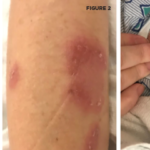“In the U.S., viruses (e.g., herpes simplex virus, cytomegalovirus and varicella zoster virus) are big on the differential,” Dr. Nowatzky noted, because “they can cause acute retinal necrosis which can mimic retinal disease in BD. However, an ophthalmologist experienced in uveitis can often diagnose BD by eye exam [because] the ocular phenotype of the disease can be specific.”
As for treatment of ocular inflammation, Dr. Nowatzky reminded us that “remission in BD eye disease must be evidenced by the absence of leakage on fluorescein angiography.”
Who Gets Behçet’s Disease?
“We all know that young male patients have the highest risk for severe BD, and patients with a family history are more likely to get the disease,” Dr. Nowatzky said. Allele frequencies for the commonly ordered HLA-B*51 are population dependent, and the prevalence of BD follows the allele frequencies of HLA-B*51 in the population.3 “HLA-B*51 percentages are highest along the Silk Road and decrease as you move farther away from it. In Turkey, for example, almost 30% of the healthy population carries HLA-B*51. As interesting as HLA-B*51 is for research purposes, it’s useless as stand-alone diagnostic tool,” he noted.4
Take-Home Points
Dr. Nowatzky wrapped up his talk with some high-yield points:
- The appearance of a mucosal lesions alone can break a diagnosis of BD but can’t make it.
- Oral and genital ulcers alone should be diagnosed as complex aphthosis, not BD.
- Diagnosing BD requires familiarity with its ocular and peripheral phenotypes, and with uncommon manifestations of more common diseases.
- Relying on HLA typing, other lab tests or histopathology to diagnose BD is not possible at present.
So remember, not all mucosal lesions are ulcers and not all ulcers are Behçet’s disease. A careful history and physical exam can help differentiate between them.
Samantha C. Shapiro, MD, is a clinician educator who is passionate about the care and education of rheumatology patients. She writes for both medical and lay audiences and practices telerheumatology.
References
- Poveda-Galleg A, Murray PI, Rauz S, et al. How to recognise a Behçet’s ulcer from other types of oral ulceration? Defining Behçet’s ulceration by an International Delphi Consultation. Clin Exp Rheumatol. 2023 Oct;41(10):2048–2055.
- Corbitt K, Nowatzky J. Inflammatory eye disease for rheumatologists. Curr Opin Rheumatol. 2023 May 1;35(3):201–212.
- Bordbar A, Manches O, Nowatzky J. Biology of HLA class I associated inflammatory diseases. Best Pract Res Clin Rheumatol. 2024 May;38(2):101977.


